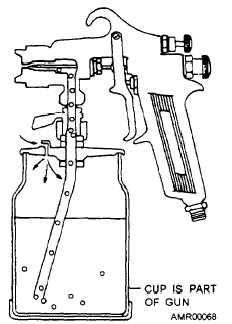SEALANTS
Figure 4-33.—Suction-feed type of spray gun.
Figure 4-34.—Suction and pressure fluid tips and air caps.
spray equipment eliminates evaporation of the volatile
substances of the mixture before they strike the surface
because the paint and air are mixed internally. Thus, a
wetter coating is applied.
CAUTION
Many of the sealants discussed in this sec-
tion may be flammable or produce toxic vapors.
When materials designated as flammable are
used, ail sources of ignition must be at least 50
feet away from the work location. Toxic vapors
are produced by the evaporation of solvents
or the chemical reaction that takes place in the
curing sealants. When sealants are used in a
confined space, such as a fuel cell, fuselage,
wing section, or table or bench operation,
adequate local exhaust ventilation must be
used. This will reduce the vapors below the
maximum allowable concentration and keep
them at that level until repairs have been
completed. Personnel must NOT eat or smoke
when they work with sealants.
Sealants are used to prevent the movement of
liquid or gas from one point to another. They are used
in an aircraft to maintain pressurization in cabin areas,
to retain fuel in storage areas, to achieve exterior
surface aerodynamic smoothness, and to weatherproof
the airframe. Sealants are used in general repair work
in the field and for maintenance and restoration of
seam integrity in critical areas if structural damage or
the use of paint removers has loosened existing
sealants.
Conditions surrounding the requirements for use
of sealants govern the type of sealants to be used. Some
sealants are exposed to extremely high or low
temperatures. Other sealants are in contact with fuels,
lubricants, and so forth. Therefore, sealants are
supplied in different consistencies and rates of cure.
The basic types of sealants are classified in three
general categories-pliable sealants, drying sealants,
and curing sealants.
Pliable sealants are called “one-part” sealants and
are ready for use as packaged. They are solids and
change little, if any, during or after application.
Solvent is not used in this type of sealant. Therefore,
drying is not necessary; and except for normal aging,
they remain virtually the same as when first packaged,
neither hardening nor shrinking. They bond well to
metal, glass, and plastic surfaces. Pliable sealants are
used around high-usage access panels and doors, and
4-50



